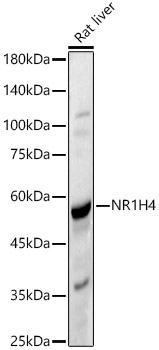
Lane 1: HepG2 lysates probed with Bile Acid Receptor NR1H4 Antibody (bs-12867R) at 1:300 overnight at 4˚C. Followed by a conjugated secondary antibody at 1:10000 for 90 min at 37˚C._x000D_
NR1H4 Polyclonal Antibody
BS-12867R
ApplicationsImmunoFluorescence, Western Blot, ELISA, ImmunoCytoChemistry, ImmunoHistoChemistry, ImmunoHistoChemistry Frozen, ImmunoHistoChemistry Paraffin
Product group Antibodies
ReactivityBovine, Canine, Equine, Human, Mouse, Porcine, Rat, Sheep
TargetNR1H4
Overview
- SupplierBioss
- Product NameNR1H4 Polyclonal Antibody
- Delivery Days Customer16
- ApplicationsImmunoFluorescence, Western Blot, ELISA, ImmunoCytoChemistry, ImmunoHistoChemistry, ImmunoHistoChemistry Frozen, ImmunoHistoChemistry Paraffin
- Applications SupplierWB(1:300-5000), ELISA(1:500-1000), IHC-P(1:200-400), IHC-F(1:100-500), IF(IHC-P)(1:50-200), IF(IHC-F)(1:50-200), IF(ICC)(1:50-200)
- CertificationResearch Use Only
- ClonalityPolyclonal
- Concentration1 ug/ul
- ConjugateUnconjugated
- Gene ID9971
- Target nameNR1H4
- Target descriptionnuclear receptor subfamily 1 group H member 4
- Target synonymsBAR, FXR, HRR-1, HRR1, PFIC5, RIP14, bile acid receptor, RXR-interacting protein 14, farnesoid X nuclear receptor, farnesoid X-activated receptor, farnesol receptor HRR-1, retinoid X receptor-interacting protein 14
- HostRabbit
- IsotypeIgG
- Protein IDQ96RI1
- Protein NameBile acid receptor
- ReactivityBovine, Canine, Equine, Human, Mouse, Porcine, Rat, Sheep
- Storage Instruction-20°C
- UNSPSC12352203
References
- Liu Y, Li Q, Wang H, et al. Fish oil alleviates circadian bile composition dysregulation in male mice with NAFLD. J Nutr Biochem. 2019,69:53-62. doi: 10.1016/j.jnutbio.2019.03.005Read this paper
- Yuan Z, Zhang H, Hasnat M, et al. A new perspective of triptolide-associated hepatotoxicity: Liver hypersensitivity upon LPS stimulation. Toxicology. 2019,414:45-56. doi: 10.1016/j.tox.2019.01.005Read this paper
- Zhao G, Elhafiz M, Jiang J, et al. Adaptive homeostasis of the vitamin D-vitamin D nuclear receptor axis in 8-methoxypsoralen-induced hepatotoxicity. Toxicol Appl Pharmacol. 2019,362:150-158. doi: 10.1016/j.taap.2018.11.002Read this paper
- Zhang Q, Hwang JW, Oh JH, et al. Effects of the fibrous topography-mediated macrophage phenotype transition on the recruitment of mesenchymal stem cells: An in vivo study. Biomaterials. 2017,149:77-87. doi: 10.1016/j.biomaterials.2017.10.007Read this paper
- Yang T, Mei H, Xu D, et al. Early indications of ANIT-induced cholestatic liver injury: Alteration of hepatocyte polarization and bile acid homeostasis. Food Chem Toxicol. 2017,110:1-12. doi: 10.1016/j.fct.2017.09.051Read this paper
- Yu L, Liu X, Yuan Z, et al. SRT1720 Alleviates ANIT-Induced Cholestasis in a Mouse Model. Front Pharmacol. 2017,8:256. doi: 10.3389/fphar.2017.00256Read this paper
- Zhou W, Lin J, Chen H, et al. Retinoic acid induces macrophage cholesterol efflux and inhibits atherosclerotic plaque formation in apoE-deficient mice. Br J Nutr. 2015,114(4):509-18. doi: 10.1017/S0007114515002159Read this paper






